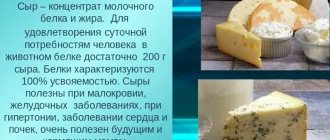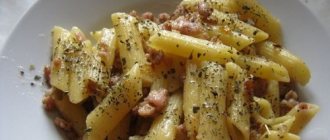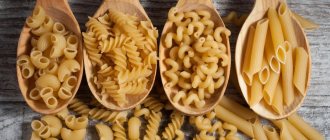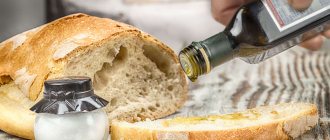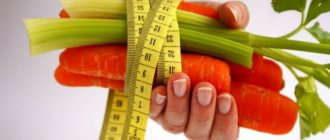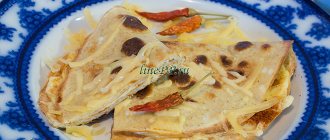Although Italians are nicknamed pasta makers, they eat several times less of this product than people in other countries. All these spaghetti, penne and farfalle have long become international. They are happily prepared and eaten in every corner of the planet. True, it is believed that eating pasta makes you feel better. But is this really so? And is the high calorie content of boiled pasta to blame for this? It should be noted that Italians are far from the fattest on the planet. Maybe they eat some other pasta? But first you need to understand what they are made of.
Pasta: product features
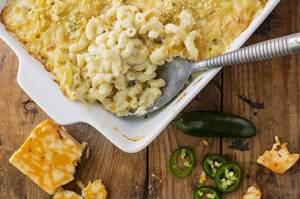
In the classical understanding of most residents of Russia, pasta is a flour product that is produced in the form of small curved tubes. Another name for them: horns. However, there are actually several dozen pasta products. They differ in appearance, features of use, but still have the same composition. Classic pasta should contain only 3 components:
- flour;
- water;
- salt.
Ideally, flour is made from durum wheat, which has a positive effect on the absorption of the product and even on the cooking process. However, on the shelves you can find pasta made from soft wheat varieties, as well as spelled or buckwheat flour. These points directly affect the calorie content of the product: depending on the flour, it will range from 335 to 356 kcal. Other components are also periodically added to the dough:
- milk (used half and half with water, softens the taste of the product);
- eggs (often such pasta is referred to as “egg noodles”, but not by all manufacturers);
- ground herbs;
- dried tomatoes;
- spices.
Milk and eggs are not typical for good Italian pasta, but flavorings in the form of herbs and tomatoes may be present in it: they have little effect on calorie content. As for various E-additives and other chemicals, they should not be in good pasta. If we consider the calorie content and nutritional value of the correct pasta, then 100 g will contain 350-355 kcal, as well as 12 g of protein, 2 g of fat and 71-72 g of carbohydrates.
Durum pasta for weight loss
On the shelves of our stores you can find packages with these semi-finished products, on which are the mysterious initial letters of the alphabet - A, B and C. They represent the varieties of wheat from which certain pasta was made.
- The letter A means that this is pasta made from durum pasta;
- The letters B and C indicate that the product is made from soft varieties. Pasta belonging to group “B” is made from glassy flour, and pasta belonging to group “B” is made from bakery flour.
In order to boil pasta suitable for preparing dietary dishes, it is necessary to choose products made exclusively from durum wheat.
- Sometimes even in pasta of group “A” there are impurities of flour from soft varieties of wheat, so before purchasing a product you need to carefully study its composition.
- Domestic manufacturers prefer to make pasta from soft varieties, since they are cheaper, which means more people can afford to buy them. Therefore, people who want to introduce durum wheat pasta into their diet should expect that this will entail additional expenses.
- Try to choose pasta made in Italy, as it will initially have a lower calorie content. A classic Italian pasta recipe calls for three ingredients: flour, water and salt. Our producers use, in addition to flour, egg yolk and olive oil, which add calories.
- If you find green or red pasta on store shelves, check that it does not contain artificial colors. Respectable manufacturers use natural additives - herbs and spices - to obtain the original color.
How many calories are in boiled macaroni and cheese?
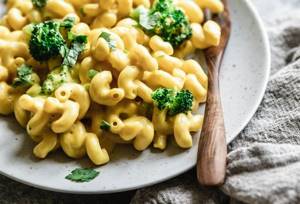
If there are no questions about the intrinsic energy value of pasta - even after cooking with salt, the indicator remains the same, then as soon as various additives appear in the dish, you have to calculate the numbers again. For mac and cheese, calorie content is difficult to predict because it all depends on the type of cheese. This dairy product today has several varieties:
- Soft cheeses. Many French cheeses with a liquid center (Brie, Camembert), as well as with mold. Most of these cheeses have fat content in the range of 40-55%, and calorie content - 290-353 kcal. This also includes ricotta (Italians use it as cottage cheese) and mascarpone, whose calorie content is 174 kcal and 412 kcal (fat content is about 80%, mascarpone is made from cream), respectively.
- Brine. Brynza, feta, as well as many favorite suluguni, Adyghe and mozzarella. All these cheeses have a fat content above 40%, although “light feta cheese” (30%) is found. They are often added to salads or baked goods. Calorie content is in the range of 208-290 kcal per 100 g.
- Semi-solid. This includes the familiar Russian, Dutch, Swiss, and Cheddar and Gouda. The largest group of cheeses with a fat content of 40-60% and a calorie content of 334-360 kcal.
- Solid. Parmesan, Grana Padano, Pecorino, Dziugas are the most famous long-aging cheeses. Their fat content is in the range of 25-38%, but the calorie content is quite high: 384-419 kcal. But due to their hardness, they are much lighter than other cheeses, so less is used directly for pasta. In terms of volume, 10 g of Parmesan is more than 10 g of Russian cheese.

Separately, it is worth mentioning Tofu cheese, which is prepared on the basis of soy milk, so its calorie content is several times lower than that of other cheeses - about 75 kcal per 100 g.
If we take the average calorie content of cheese without regard to the group - 320 kcal, and assume that 1 serving of pasta (80 g of dry product) takes approximately 10 g of cheese, it turns out that there are 312 kcal per serving. But you need to take into account that many housewives also add vegetable or butter, as well as an egg, to this dish. As a result, another 100-110 kcal is added (1 egg and 1 tsp of oil).
3 Ingredient Blue Cheese Pasta Sauce
Express Pasta with 3 Ingredient Blue Cheese Pasta Sauce for blue cheese lovers! Ideal for students and busy people. This is actually what I ate in Paris with Roquefort.

First, make the 3-Ingredient Blue Cheese Pasta Sauce by combining shredded blue cheese and cream.

Add chopped garlic.
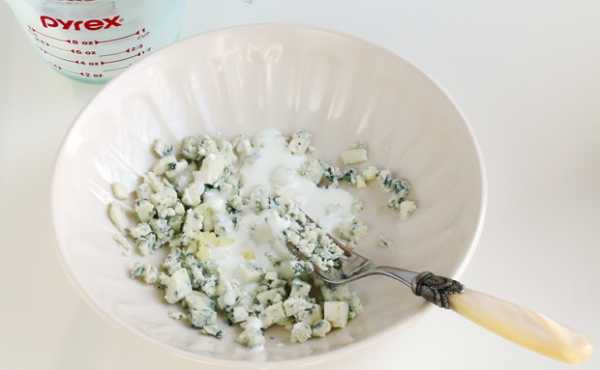
Any blue cheese will work, but today I used Italian Gorgonzola. French Roquefort is also great, but Roquefort is spicier.
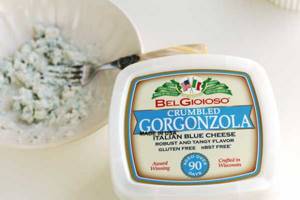
Prepare pasta of your choice according to package directions. And take 1/4 cup of pasta cooking water.

Add blue cheese sauce.

Drain the pasta and return it to the pan. And add cheese sauce.

Cook over medium heat until the sauce reaches the desired thickness.

Serve immediately. Very tasty with peppers, walnuts, young herbs and tomatoes! Enjoy!!
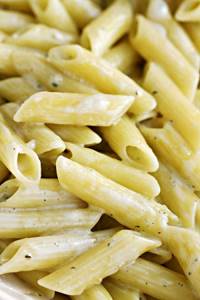
Express Pasta with 3 Ingredient Blue Cheese Pasta Sauce
Ingredients
For the Blue Cheese Pasta Sauce:
- 2 ounces blue cheese, preferably Roquefort or Gorgonzola (55 g)
- 2 tablespoons heavy cream
- ¼ t garlic powder
To submit:
- Pinch of black pepper for seasoning
- Toasted walnuts, baby greens and tomatoes, optional
Instructions
- 1.In a bowl, add 2 ounces shredded blue cheese. Combine 2 tablespoons heavy cream and ¼ teaspoon minced garlic; postpone.
- 2. Cook the pasta of your choice in boiling water with salt according to package instructions. When cooked, remove ¼ cup pasta water and add blue cheese pasta sauce.
- 3. Drain the pasta and return it to the pan. Add blue cheese sauce. Over medium heat, continue stirring until the sauce thickens.
Nutrition information
Serving Size: 2
3.5.3208

.
How many calories are in a serving of macaroni and cheese?
Nutritional value and chemical composition of Macaroni and Cheese.
| Nutrient | Quantity | Norm** | % of the norm in 100 g | % of the norm in 100 kcal | 100% normal |
| Calorie content | 127 kcal | 1684 kcal | 7.5% | 5.9% | 1326 g |
| Squirrels | 5.1 g | 76 g | 6.7% | 5.3% | 1490 g |
| Fats | 3.7 g | 56 g | 6.6% | 5.2% | 1514 g |
| Carbohydrates | 18.1 g | 219 g | 8.3% | 6.5% | 1210 g |
Composition of the product
Nutritional value of boiled pasta from durum wheat:
- proteins – 11.5 g;
- fats – 2.9 g;
- carbohydrates – 67;
- fiber – 0.1;
- water – 13 g.

Calorie content per 100 g – 345 kcal.
The product contains a lot of carbohydrates with a relatively low calorie content.
Chemical composition:
- vitamin A;
- vitamin B1, B2, B5, B6, B9, H, PP;
- vitamin E;
- calcium;
- chlorine;
- phosphorus;
- sodium;
- potassium;
- sulfur;
- magnesium;
- zinc;
- silicon;
- copper;
- iodine;
- chromium;
- molybdenum;
- manganese;
- cobalt;
- iron;
- saturated fatty acids;
- starch.
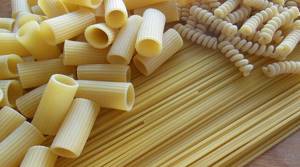
How many calories are in pasta
Pasta is a common product used to make side dishes. It is believed that the product has a high calorie content, and therefore it should not be consumed during weight loss or to maintain weight if you are prone to obesity. However, knowing how many calories are in pasta , and cooking methods to reduce calories, you can eat pasta at lunchtime without restrictions.
Pasta is a flour product, but its variety today is so great that you can find lower-calorie varieties to eat during a diet. Next, types of pasta, cooking features in order to reduce calorie content, as well as examples with recipes will be presented in detail.
Dietary properties:
How many calories are in pasta, what dietary properties they have, all this is very interesting for those who are trying to lead a healthy lifestyle, monitor their health and figure. So we will try to answer these questions in the next article.

Everyone knows that pasta is carbohydrates. And carbohydrates are harmful, especially for overweight people. But carbohydrates, like fats, are a source of energy in the body: the combustion of 1 g of carbohydrates produces 3.75 kcal. In addition, they are part of cells and tissues, enzymes, some hormones, blood clotting factors, etc.
Carbohydrates are divided into monosaccharides (glucose and fructose), disaccharides (sucrose and lactose) and polysaccharides (starch, fiber, pectin, glycogen). The highest starch content is in pasta. In the intestines it is slowly digested and broken down into glucose.
The muscles and liver contain about 1.5 kg of glycogen, which is a reserve of carbohydrates in the body. If the intake of carbohydrates is insufficient, these reserves are quickly consumed, and subsequently carbohydrates in the body are synthesized from proteins and fats, which contributes to the accumulation of under-oxidized metabolic products in the blood.
Lack of carbohydrates in the diet for a long time or their sharp restriction disrupts their synthesis from proteins and fats, which contributes to a decrease in blood sugar, a decrease in mental and physical performance, weakness, drowsiness, dizziness, headaches, hunger, and trembling hands.
An excess of carbohydrates in the diet, especially easily digestible ones, is also harmful to the body.
Pasta is very common. They are used in almost all countries of the world. They are made from wheat, rice, buckwheat flour. In Europe and Russia, pasta made from wheat flour is most often consumed.
Types of pasta
Pasta is made from a dough using wheat flour and water. As a result, the product can be classified as complex carbohydrates necessary for the body due to prolonged saturation and energy production for normal life. Nutritionists do not recommend using varieties for quick cooking, but giving preference to pasta made from durum wheat. At the moment, pasta varies in composition, shape and even color.
Among the long varieties there are:
- vermicelli,
- spaghetti,
- spaghettini,
- fettuccine,
- capellini, etc.
Among the short pasta products, the following varieties are distinguished:
- tortiglioni,
- maccheroni,
- cavatappi, etc.
There are also curly varieties:
- farfalle (we call them “butterflies”),
- conchiglie (or “shells”),
- capeletti (similar to small Russian dumplings), etc.
As a result of the huge number of varieties, one can count more than 200 pasta dishes, the cooking features of which should be based on reducing calories in order to lose weight or maintain a slim body.
Pasta with blue cheese sauce - My favorite pastime


In the same pan, saute the mushrooms and onions using the remaining butter or olive oil for about 5 minutes.

Simmer uncovered for 20-30 minutes until reduced by half. Season with pepper and salt if necessary.
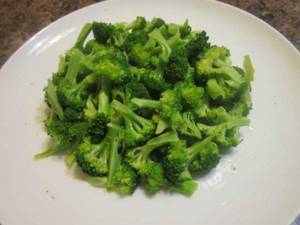
Meanwhile, arrange the broccoli on a plate, cover and microwave for about 2 minutes. Don't overcook it, it should be crunchy.
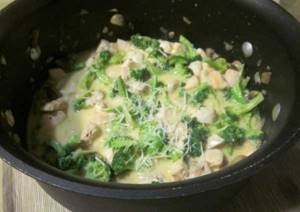
Add broccoli and chicken to the sauce. Heat until hot. Add grated Parmigiano-Reggiano and crumble blue cheese on top.
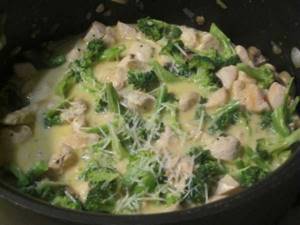
Stir the cheeses.
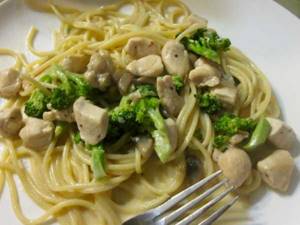
Serve sauce over pasta.
Pasta with blue cheese sauce
Cooking time : 10 minutes; Cooking time : 50 minutes; Serves : 4
Compound
- 3-4 tablespoons butter or olive oil or a mixture of both
- 500 g (1 lb) skinless, boneless chicken, diced
- 125 g (½ lb, 5 oz) mushrooms, finely chopped
- Small red onion, finely chopped
- All-purpose flour 2 level tablespoons
- 125 ml (½ cup) good quality white wine
- 375 ml (1½ cups) good quality chicken broth (homemade is best)
- 250 ml (1 cup) 35% cream (cream)
- Fresh grated Parmigiano Reggiano cheese
- 50-100 g (3-4 oz) blue cheese (you can adjust the amount to suit your taste)
- 350 g (12 oz) Pasta
Instructions
- Season the chicken with salt and freshly ground pepper. Heat 1 tablespoon of oil in a frying pan and stir-fry the chicken over high heat until no longer pink and cooked through. Set aside.
- In the same pan, fry the mushrooms and onions in the remaining butter or olive oil for about 5 minutes. Add flour and cook for 1 minute. Slowly add broth, stirring continuously until mixture is smooth.
- Add wine and cream and stir. Simmer uncovered for 20-30 minutes until reduced by half. Season with pepper and salt if necessary.
- Meanwhile, cook the pasta in plenty of salted water until al dente. Drain.
- Place the broccoli on a plate, cover and microwave for about 2 minutes. Don't overcook. (or add broccoli to pasta during the last three minutes of cooking)
- Add broccoli and chicken to the sauce. Heat until hot.
- Add grated Parmigiano Reggiano and crumble blue cheese on top. Stir the cheese. Serve sauce over pasta.
Like:
Like
Related
.
About the benefits of boiled pasta
Pasta is a high-carbohydrate product containing a huge amount of fiber. It cleanses the body of waste and toxins and helps speed up metabolism. Slow carbohydrates saturate the body for a long time, so you shouldn’t give up boiled pasta even on a diet.
Slow carbohydrates, which enter the human body in the form of boiled pasta, normalize blood sugar levels, causing long-term saturation. The dish can be eaten with a small amount of butter, or better yet, with sour cream sauce, to which spices and other herbs are added.
Practical tip: It is recommended to undercook the pasta, which adds additional flavor. Among other things, this type of cooked pasta is healthier and increases satiety.
Other pasta
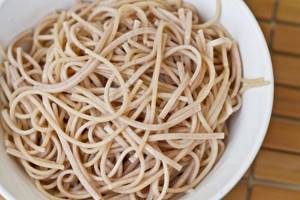
No matter how much you would like it, ordinary pasta can hardly be considered a dietary product. However, the high carbohydrate content, even if it does not add a kilogram, is still unlikely to help get rid of them. For those who not only need to get in shape after the holidays, but also significantly lose weight, nutritionists strongly recommend giving up pasta made from wheat flour. However, they can be replaced by those made from rice or buckwheat flour.
This will definitely be healthy pasta. Calorie content per 100 grams is no more than 100 kcal. In addition, both rice and buckwheat are slow carbohydrates that take much longer to digest. In addition, these cereals contain more vitamins and minerals. Most diets do not have any restrictions on their use. By the way, both rice and buckwheat noodles are eaten with pleasure in Japan. Are there many obese people among them? Perhaps this is all due to the fact that they practically do not consume pasta, which is familiar to Europeans.
About energy value
The paste contains about 400 kilocalories in 100 g of pure product. You can learn about BZHU - the content of proteins, fats and carbohydrates - from the instructions provided on the packaging. When losing weight, you need to count the calories that come from the dry amount of pasta. When boiled, they increase in size, so it is necessary to calculate the calorie content of the finished dish carefully and correctly.
The approximate calorie content of pasta made from durum wheat and others is presented in the table.
| product | energy value per 100 g |
| Boiled from durum wheat | 112 kcal |
| Boiled with butter | 135 kcal |
| Boiled buckwheat | 139 kcal |
| Boiled with mushrooms | 174 kcal |
| Boiled with cheese | 224 kcal |
In most cases, preference is given to Italian spaghetti, which is attractive, easy to prepare, loved by children, and provides great opportunities for preparing various dishes. They can be consumed with oil in small quantities in pure form. The calorie content of spaghetti per 100 grams is 344 kcal.
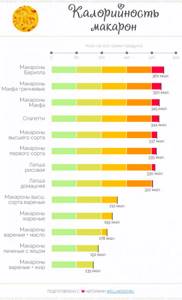
Please note: The calorie content of a dish directly depends on the additional components to the pasta. Indicators decrease if the paste is flavored with vegetable oil rather than butter. You can use sour cream sauces for taste - sour cream with finely chopped vegetables and herbs.
How and when can you eat pasta without gaining weight?
People prone to obesity give up their favorite pasta, spaghetti. Food made from them can actually lead to weight gain if it is cooked with meat and rich, fatty sauce. Pasta and spaghetti are not so dangerous with a properly composed diet.
In order not to gain weight from eating, you need to buy expensive flour products, hard cheese and eat no more than 100 g of the product. Nutritionists recommend doing ten squats before using it. This helps reduce appetite. Among the cheeses for pasta, it is better to choose parmesan, tofu, and mozzarella. They should be used to powder pasta.
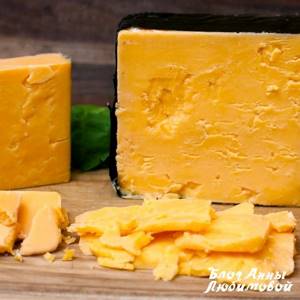
The daily portion should not exceed 200 grams. It is better to consume them only in the morning or at lunch. If a person is exposed to physical activity during the day, portions can be increased. The main thing is to compare the expenditure of calories and their consumption. The body must receive the necessary fats, proteins, minerals, vitamins in order to function normally.
About choosing a useful product
In order for the paste to bring maximum benefits to the body, you need to know the rules for choosing the product in question.
For this, the following factors are taken into account:
- it is important to pay attention to the instructions, where KBZHU is written - the content of calories, proteins, fats and carbohydrates - in pasta recommended for weight loss there should be at least 10 g of protein per 100 g,
- good pasta is sold only in packages,
- the color should not be bright - this indicates the use of dyes,
- if there are white specks on the surface, it means that the purchase is rejected - this is low-quality flour that did not dissolve during the process of kneading the dough,
- a musty smell indicates improper storage of the product - it should not be consumed,
- packaging with pasta must be a sealed transparent plastic bag (it is important to be able to independently examine the contents of the bag),
- during cooking the pasta, no foam should form on the surface, the water should be clear, without additional shades,
- the cost of a quality product is above average.
The choice of form and manufacturer is carried out at your own discretion and financial capabilities.
Please note: Pasta produced by Makfa and Barilla are especially popular. The first one is affordable for most buyers. Barilla products are somewhat more expensive. Both offer durum wheat pasta.
Navy pasta
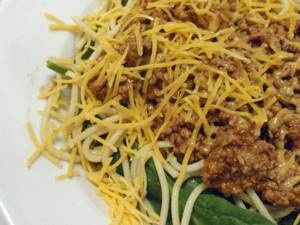
The worst combination, according to nutritionists, is pasta and meat, especially fried meat. Fast carbohydrates combined with a lot of fat and protein can ruin even the most chiseled figure. So those who are losing weight or prone to obesity are forced to forget about naval pasta. If you cook them as the cookbook recommends, you will get a tasty, but very high-calorie dish.
But you can slightly reduce their calorie content. Navy-style pasta will turn out just as good with chicken breast. In addition, carrots and onions can be stewed rather than fried, as is customary. And, of course, it is better to use only durum wheat pasta. It’s best to use spaghetti instead of noodles. As a result, it turns out that the calorie content of 1 serving will be about 250 units. Still, occasionally you can afford this for lunch.
About cooking methods and their effect on calorie content
The news that the calorie content of fried pasta is higher than boiled pasta will not surprise anyone. But not everyone knows how to use methods to reduce performance.
Where the following features stand out:
- if you use additives in the form of spices during cooking, you can increase the calorie content of the product - even using broth instead of water noticeably changes the indicators in question,
- you need to look at the pack to find out the calorie content of the product - often even the shape of pasta affects the indicators (for example, cones and spaghetti from the same manufacturer have different indicators),
- adding sauces, sour cream, ketchup, mayonnaise to ready-made pasta significantly increases the energy value - often 1.5 times if there are a lot of additives in quantity,
- macaroni and cheese have 2-3 times more calories than a simply cooked product,
- The energy value of fried pasta doubles if you simply use vegetable oil.
Boiled pasta without adding oil contains approximately 115 kcal per 100 g of finished product. Eating them will not cause weight gain unless you add fatty additives to the dish.
Dietary cooking methods
It is important how to cook pasta: not only the taste of the dish, but also its calorie content depends on it. And in this case you need to be attentive to every little detail.

Pay attention to the pasta packaging to determine the cooking time. As a rule, this takes from seven to twelve minutes.
How to make pasta less calorie? You need to subtract a couple of minutes from the time indicated on the product package to make the pasta slightly undercooked. This way you can reduce the glycemic index of the product to 40 units.
Actually, in Italy all pasta is prepared this way - the core of the pasta should be slightly hard so that a person needs to make a little effort to experience it.
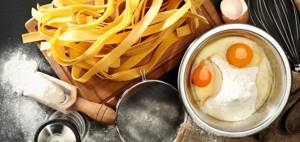
The glycemic index shows how foods affect blood glucose levels after they are absorbed by the body. The lower this figure, the better for human health.
For comparison, cooked pasta has a glycemic index of 50 units. That is, in this way it is possible to reduce this figure by 20%.
Pasta recipes
It is necessary to provide recipes for some dishes that contain pasta, but will not affect your figure.
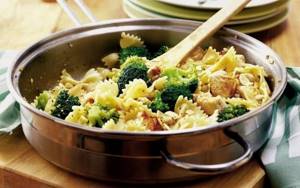
Pasta with chicken and broccoli
This dietary dish is balanced and can be eaten for breakfast or lunch.
The cooking sequence is as follows:
- Cut the chicken fillet into cubes and place it in a heated frying pan with vegetable oil. Fry with onions and bell peppers, add broccoli and water to simmer all the products.
- While the vegetables are stewing in a saucepan, you need to boil water and pour in the pasta for cooking. Cook them for no more than 8-10 minutes.
- Place the boiled pasta in the pan with the meat and vegetables. Simmer for 10 minutes.
Serve the dish hot in its pure form. You can add fresh vegetables.
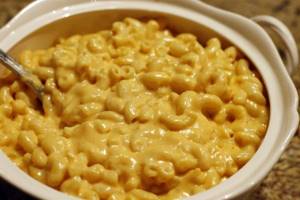
Macaroni with cream and cheese
The preparation of the presented dish is simple and is carried out in the following sequence:
- Pasta is boiled in salted water.
- At the same time, for cooking, you need to heat the cream in a frying pan or Dutch oven, add crumbled cheese. Wait for it to dissolve.
- Place the boiled horns on a plate and pour the sauce over them.
The presented dish turns out to be more high in calories, so when losing weight it is better to refrain from eating it. If you want to try something new, you can use it in small quantities in the first half of the day.
Fettuccine with seafood and tomatoes
Fettuccine is a thick noodle that replaces traditional spaghetti.
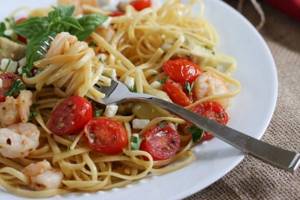
Cooking occurs in the following sequence:
- Boil the noodles until tender in salted water.
- Fry onions, tomatoes and seafood cocktail in a frying pan with vegetable oil for 10 minutes.
- Place noodles on a plate and top with a few spoons of sea cocktail with vegetables.
The recipe can be changed a little if you put the noodles in a frying pan with a sea cocktail and vegetables.
Pasta with green beans
The cooking principle is similar to the recipe described above using a sea cocktail.
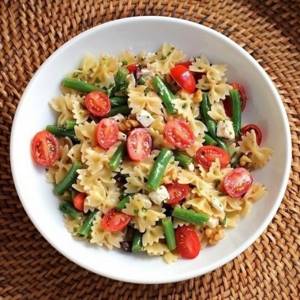
To do this you need to do the following:
- Boil the pasta until cooked according to instructions.
- Peel the tomatoes and fry along with onions, garlic and green beans in a frying pan with vegetable oil for 3 minutes.
- Place the pasta in the vegetable stock and continue to simmer for 2 minutes.
For this dish, it is better to use farfalle rather than standard cones - the appearance will take on new colors.
Pasta with tuna
For this dish, tuna is used in its own juice or vegetable oil.
The cooking technology is presented in the following sequence:
- Boil the pasta until tender.
- Separately, place tuna and tomato paste in a frying pan. Simmer the contents for 3-4 minutes.
- Place pasta in a plate and top with tuna mixture.
Decorate the dish with chopped herbs. If you want to change the taste a little, just add a few cloves of garlic or peas to boiling water. Pasta is in demand in any cuisine, and especially in European cuisine, where there are numerous varieties of pastas - Carbonara, Bolognese and others. It is only important, when using traditional recipes, to give up fatty additives. They increase calorie content and lead to the deposition of fat cells, which negatively affects a person’s figure and health.
Secrets of serving dishes on the table
Culinary experts strongly recommend not rinsing cooked spaghetti, vermicelli, etc. with water, as this changes their taste.
And in order not to add butter to pasta, there is a little trick. While still cooking, add one tablespoon of vegetable oil, preferably olive, to boiling water. Yes, this will also affect the calorie content of the finished dish, but not as much as butter or vegetable oil, but added to already cooked products.
This trick will preserve the taste of the product, and at the same time the pasta will not stick to each other. But in order to delay the cooling time of the dish, you can resort to a method popular in Italy and preheat the plate before serving food on it. You can use a microwave oven for this purpose.
When calorie content is one of the most important factors in shaping your diet, you don’t need to immediately dismiss pasta based on its high energy value.
Pasta will allow you to enrich your menu with a large amount of complex carbohydrates that can energize you. This is especially important when a person supplements a nutritious diet with regular exercise. The carbohydrates received in the first half of the day will be more than enough for him even for an evening workout.
An important condition: pasta must be made from durum wheat, since it contains slow, not fast, carbohydrates. The body spends several hours on their assimilation, due to which the effect of vigor delayed over time is achieved.
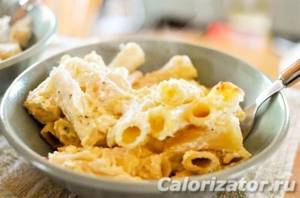
How to make Macaroni and Cheese
Pasta is considered not a completely dietary dish, and even with cheese. But sometimes you can treat yourself to such a dish, especially if both the cheese and pasta are hard varieties.
- Pasta - 0.5 kg.
- Egg - 1 pc.
- Cheese - 30 gr.
- Sunflower oil - 10 gr.
Nutritional value of the “Macaroni and Cheese” dish (per 100 grams):
Calorie content of pasta per 100 grams (boiled, hard, with cheese, etc.)

340 kcal, boiled:
175 kcal* * average value per 100 g, depends on the type of flour, type of pasta and cooking methods
Pasta is a popular dish characterized by its nutritional value and high energy value. Different types - spaghetti, noodles, pasta - are used to prepare casseroles, soups and cold appetizers.
Navy pasta, preparation and nutritional value
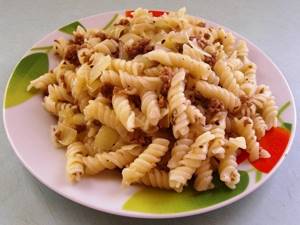
The calorie content of navy-style pasta directly depends on the type of minced meat used in preparation.
Minced pork with a high fat content gives the dish more calories.
To significantly reduce the number of calories in this tasty dish, you can use minced meat from lean meats: veal, chicken, lean beef, for example, the calorie content of pasta with chicken will be 300 kcal, and with minced meat it is already 234 kcal per 100 grams.
Oil can also be almost completely excluded from the cooking ingredients.
In this case, the minced meat can be stewed in a frying pan with a minimum amount of regular or filtered water and 1 spoon of oil.
Ingredients:
- Pasta 450 grams;
- ground beef;
- 350 grams, vegetable oil;
- salt pepper.
Cooking method:
Boil them, and the cooking water should be salted.
Immediately drain in a colander and rinse very thoroughly.
Fry the minced meat with onions well in a heated frying pan, adding olive oil, and if not, then vegetable oil.
Calorie content of navy pasta per 100 g: 200.45 kcal.
The nutritional value:
How many calories are in 100 grams of pasta?
Pasta is not only tasty, but also a healthy product. Due to the content of vitamin B in products made from durum wheat, a person feels a surge of strength and energy for a long time. Amino acids help normalize sleep and mood, and fiber helps remove all harmful substances from the body and restores intestinal function.
The Italian product differs from the domestic one in composition. In the first case, only flour and water are used, in the second, eggs and butter are added.
Flour for making pasta can be of baking, hard, or glassy varieties. The first option is considered more beneficial for the body. Depending on the type, the calorie content of the product (dry) is 320-360 kcal. About the same numbers apply to buckwheat or white rice.
For your diet, it is better to choose products made from rice or buckwheat flour.
The products of the well-known brand “Makfa” (only durum wheat is used) have 345 kcal, the products do not become overcooked and keep their shape. Barilla has a higher figure - 360 kcal. Spaghetti, bows, lasagna sheets, feathers are distinguished by their excellent taste and high quality. Manufacturers can add tomatoes, spinach, carrots, spices and herbs to create beautiful and more savory pasta.
"Correct" pasta
Pasta sold in stores is usually made from flour and water. It is the quality of the raw materials that ultimately determines how useful the finished product will be. Durum pasta is considered the most healthy. The calorie content per 100 grams, however, will be the same as that of cheaper, soft ones. Typically it is about 350 kilocalories per 100 grams in dry form. But what's the difference?
The fact is that almost 80% of pasta consists of carbohydrates. And “soft” pasta is predominantly fast carbohydrates, which are quickly broken down into fat and water. But hard foods are digested more slowly, which means that the feeling of hunger will come much later. In addition, if you boil them until al dente, as the Italians do, more nutrients will be retained. Do not forget that the calorie content of boiled pasta is 2 times less, that is, about 150 kcal per 100 grams.
Calorie content of boiled and fried pasta
The energy value of pasta depends not only on its type, but also on the products that are added during the cooking process. When cooking, the numbers decrease by more than 2 times (about 120 kcal per 100 grams). This is due to the increase in volume of products after boiling.
One standard serving of boiled pasta (150 g) contains 180 kcal.
Additives (butter, sauces, cheese, sour cream) significantly change the value of the finished dish. For boiled products with butter (2 tablespoons), the indicator will be almost 180 kcal per 100 g. Read about the properties and calorie content of butter here.
Nutritionists advise replacing animal oil with vegetable oil. In the homeland of pasta, olive oil is used; when it is added, the energy value is reduced by 20 units (160 kcal). Find out the calorie content of vegetable oils in our article. If you want to fry pasta in oil, you should pay attention to the high calorie content of the finished dish - more than 190 kcal.
Calorie content of pasta
The calorie content of pasta mainly depends on the type of wheat that is used for its preparation and on the manufacturing method. Cheaper varieties made from non-durum wheat contain more fast carbohydrates, which are directly related to higher calorie content. The calorie content of boiled pasta made from durum wheat is lower per 100 g of product, since they contain less carbohydrates.

The calorie content of pasta is usually indicated on the packaging and averages 350 kcal. But on the packaging we are talking about the calorie content of dry pasta, so this figure is not taken into account when calculating the calorie content of the finished dish, but to find out how many calories are in boiled pasta, you need to know the ratio of dry and ready pasta. It is 1 to 2, so if the figure indicated on the package is divided by 2, we will get the calorie content of the prepared product. In this case it will be 175 kcal.

The standard daily portion is considered to be 200 g of pasta or half a small plate - this is the norm for an adult of average build. If you have a tendency to gain weight, you can eat pasta several times a week. If you are on a diet and want to avoid gaining weight, then the maximum serving of ready-made pasta per day is 100 g (dry 50 g).
Again, you need to estimate how many calories are in your favorite dishes - whether you eat pasta with milk, cheese or sauces - and, depending on this, always know your consumption rate.
It is impossible to name one number for everyone. But you can consider how many calories are in different types of pasta.
Calorie content of pasta dishes
If you boil pasta and add cheese to it, you will get a fairly high-calorie dish (330 kcal) that is not suitable for dietary nutrition. You can reduce the indicator if you use low-fat varieties of dairy product in an amount of no more than 1 tablespoon. You can read about the calorie content of different types of cheese in our publication.
Popular dishes where pasta is the main ingredient:
- baked with egg – 152 kcal;
- with beef stew – 190 kcal;
- with minced meat (navy style) – 230 kcal;
- with pieces of beef – 215 kcal;
- noodle soup – 90 kcal;
- with chicken breast – 290 kcal;
- with Bolognese sauce – 200 kcal.
The most dietary option is durum spaghetti with the addition of vegetables or seafood. The value of such a dish will be only 110-120 kcal.
The quality of the paste, beneficial properties, and energy value depend on the varieties of cereal crops used and manufacturing technologies. During the diet, you should limit consumption to one small serving every 2-3 days.
Delicious and healthy dishes
Pasta, spaghetti and cheese can be used to prepare a variety of dishes with excellent taste and aroma. The recipe is selected according to personal preferences and needs. It can be dietary or designed for people who are not at risk of becoming overweight.

Pasta in the oven
- 350 grams of hard snail pasta;
- 20 grams (two tablespoons) of wheat flour;
- 125 grams celler;
- 500 grams of low-fat milk;
- 30 grams of parmesan;
- salt, black pepper, nutmeg to taste.
Boil pasta in water without salt until half cooked, drain in a colander. The cottage cheese is mixed in a food processor until a homogeneous mass is created. The oven is preheated to 190ºC. Take a deep frying pan or a fireproof pan, beat the flour with 60 ml of milk in it. Gradually add the remaining milk to the resulting mass.
Ways to reduce calories
The calorie content and glycemic index of boiled pasta can be significantly reduced if, during cooking, the products are brought to an al dente state, that is, slightly undercooked. Ready-made pasta in this case retains a hard core and produces a slight crunch when consumed.

Macaroni and cheese (calorie content increases significantly due to the presence of additional ingredients) with the addition of sunflower oil and cheese can hardly be called a dietary product.
In order to cook pasta using the method described above, it is enough to subtract 1-3 minutes. from the cooking time indicated on the package. If pasta is cooked on average for about 7-10 minutes, then the specified time period must be reduced to 5-7 minutes.
How to cook pasta correctly?
But whatever the calorie content of dry pasta, it is very important to cook it correctly. Only then can you expect that when finished they will not become a heavy burden for the body. Proportions are very important: for every 100 grams of dry product, take 1 liter of water, 10 grams of salt and 1 tablespoon of olive oil.
Boil water in a large saucepan on the stove, add salt and add pasta. The first 10 minutes you need to stir a couple of times. Then you should add the oil, mix again and cook until it tastes al dente. This means that if you taste the pasta, it will be slightly tough. Then you need to put it in a colander, drain the water and under no circumstances rinse it. This is how pasta is prepared in Italy. This is how they should be cooked.
Sources:
https://prokalorijnost.ru/kalorijnost-makaron-po-flotski-s-syrom-maslom https://notefood.ru/produkty/kalorijnost-produktov/makaronu-kaloriynost.html https://www.syl.ru/ article/153240/new_kaloriynost-makaron-otvarnyih-s-maslom-syirom-i-po-flotski
Pasta with cheese: composition, calorie content and nutritional value per 100 g
Preheat the oven to 175C.
Boil water in a pasta pot.
Grease a 20x20 cm baking dish with butter.
| Spaghetti |
Cook pasta according to package directions until al dente. Drain the water and set the pasta aside.
| Crackers |
Sprinkle with green onions, cut and serve.
What are the benefits and harms?
In order for pasta to become one of the permitted products on the diet menu, the dish must be properly prepared and served. Whether the product will cause harm or benefit to the body depends on what type of pasta is used for preparation. Pasta made from durum wheat is distinguished by the presence of a large number of useful components.
They are a source of complex carbohydrates and contain:
- fiber, which improves the digestion process;
- vitamin B, which plays an important role in the functioning of the nervous system and metabolic processes;
- protein that provides long-lasting satiety;
- amino acid tryptophan;
- iron;
- nicotinic acid;
- vitamin E, which has a beneficial effect on the functioning of the reproductive system.
In addition, whole grain pasta, when consumed regularly, reduces blood cholesterol levels. Pasta made from glassy flour, which contains large amounts of starch and gluten, are considered less healthy.
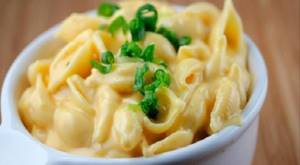
In this regard, regular pasta contributes to a surge in insulin and converts carbohydrate-derived glucose into fatty acids, which are stored in subcutaneous fat.
Possible harm to the product is associated with the following features:
- high calorie content;
- low nutritional value when pasta is made from soft flour;
- the risk of developing diabetes and cardiovascular diseases if you consume low-quality pasta.

